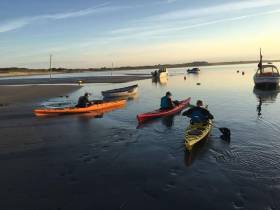Displaying items by tag: St George's Channel
Football Lost Off Waterford Beach Makes Landfall in Wales a Week Later
A family in Waterford got a big surprise at the weekend when they learned a football they’d lost in the water was found on the Welsh coast.
As the Irish Examiner reports, Aline Denton was walking on the shore near her Llanrhystud home when she spotted the ball bearing the distinctive GAA logo and the name Aoife Ní Niocaill.
After posting the discovery on her Facebook page, it took on a life of its own — and within hours Aoife’s father has spotted the image and got in touch.
He informed her how the ball had been lost as the tide turned off Woodstown beach on Sunday 10 January.
In the days since, it turns out it had been carried across St George’s Channel and the Irish Sea to the shores of Cardigan Bay.
The Irish Examiner has more on the story HERE.
Ireland-To-Wales Kayaking Challenge Is Under Way
#Kayaking - Four friends are currently padding across St George’s Channel by kayak in an effort to turn the tide on suicide.
According to Independent.ie, the group comprising hotelier Liam Griffin and Defence Force members Stephan Happe, Araon Kearney and David Feehan was scheduled to leave Wexford this morning (Saturday 23 June) for the crossing to St David’s Head in South Wales.
The 100km route is expected to take over 13 hours to complete by this evening — a challenge and a half but one the foursome, who have trained with solo kayak record-breaker Mick O’Meara, are more than capable of handling.
Independent.ie has more on the story HERE.
























